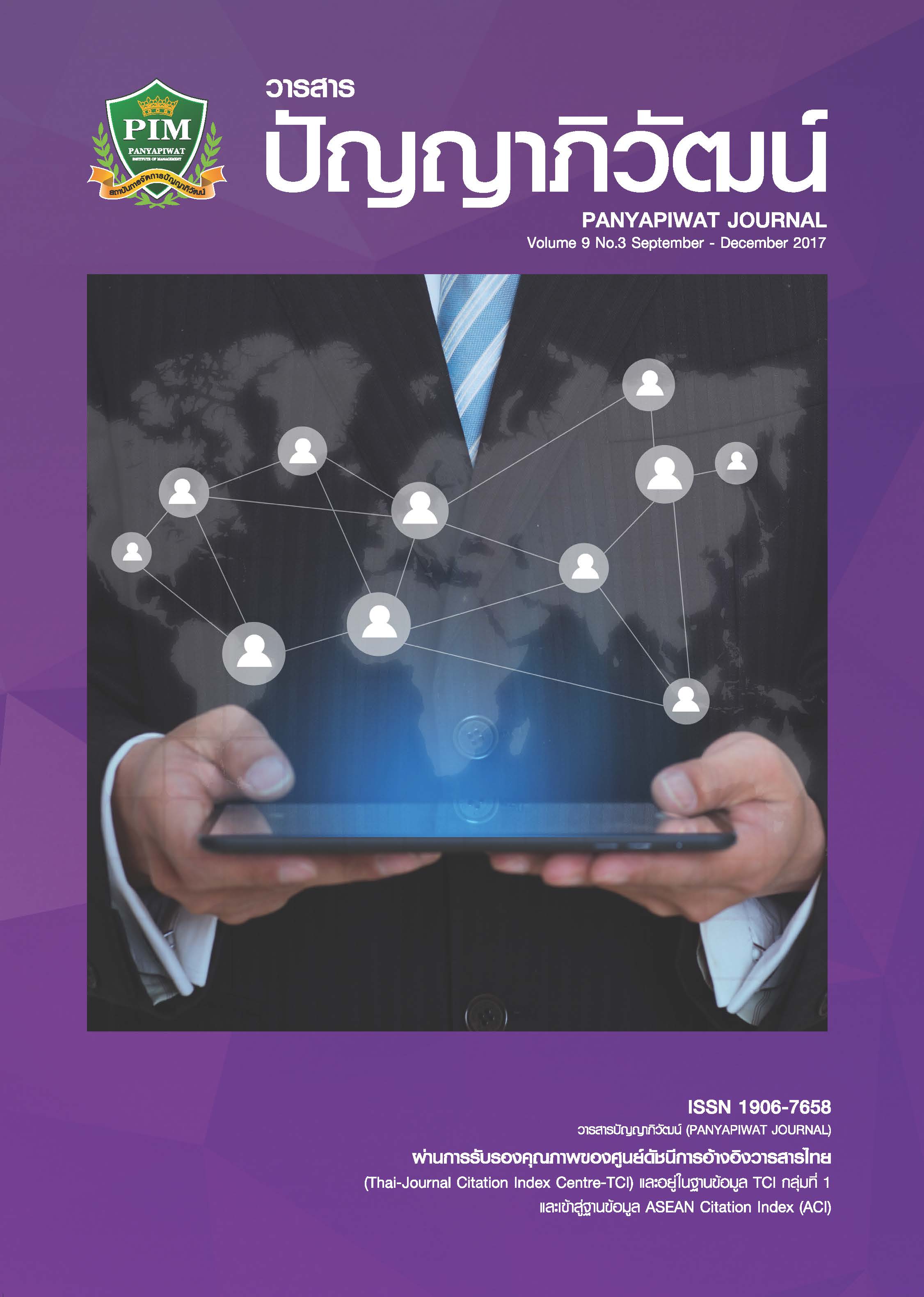กระบวนการถ่ายทอดการสื่อสารแบบเครือข่ายจากพันธมิตรภาคธุรกิจสู่พันธมิตรภาคการศึกษา
Main Article Content
บทคัดย่อ
งานวิจัยนี้เป็นงานวิจัยเชิงคุณภาพ มีวัตถุประสงค์เพื่อศึกษากระบวนการถ่ายทอด ปัจจัยแห่งความสำเร็จ และปัจจัยที่เป็นอุปสรรคในการสื่อสารแบบเครือข่ายจากพันธมิตรภาคธุรกิจสู่พันธมิตรภาคการศึกษาโดยใช้วิธีการวิเคราะห์เอกสาร (Document Analysis) การสังเกตแบบมีส่วนร่วม (Participatory Observation) และการสัมภาษณ์เชิงลึก (In-depth Interview) ผู้นำความคิด (Opinion Leader) สมาชิกของเครือข่ายในระดับ Key Informants จำนวน 15 คน โดยออกแบบคำถามเป็น 5 ประเด็นหลัก คือ 1) กระบวนการสื่อสาร S-M-C-R 2) การวิเคราะห์เครือข่าย 3) กระบวนการถ่ายทอด 4) ปัจจัยแห่งความสำเร็จ 5) ปัจจัยที่เป็นอุปสรรค
ผลการวิจัยจากการวิเคราะห์เอกสารพบว่า องค์กรธุรกิจร้านสะดวกซื้อมีการนำการสื่อสารแบบเครือข่ายมาใช้อย่างเป็นรูปธรรมในรูปแบบของการจัดตั้งสำนักบริหารเครือข่ายทางธุรกิจ (Office of Business Networking Management) และได้ถ่ายทอดเครือข่ายพันธมิตรภาคธุรกิจมาสู่พันธมิตรภาคการศึกษาให้แก่มหาวิทยาลัยแห่งองค์กรธุรกิจ (Corporate University) ผู้วิจัยจึงเลือกศึกษากระบวนการถ่ายทอดการสื่อสารแบบเครือข่ายของทั้งสององค์กรตามประเด็นหลักข้างต้น ผลการศึกษาจากการสังเกตแบบมีส่วนร่วมและการสัมภาษณ์เชิงลึก พบว่า 1) กระบวนการสื่อสาร S-M-C-R สำนักบริหารเครือข่ายทางธุรกิจ ขององค์กรธุรกิจร้านสะดวกซื้อ อยู่ในฐานะของ “ผู้ส่งหรือผู้ถ่ายทอด” และหน่วยงานเครือข่ายของมหาวิทยาลัยองค์กรธุรกิจ อยู่ในฐานะของ “ผู้รับหรือผู้รับการถ่ายทอด” โดยใช้เนื้อหาการสื่อสารในการแนะนำหน่วยงานและองค์กรให้เป็นที่รู้จักเพื่อนำไปสู่การสร้างสัมพันธ์และสร้างโอกาสความร่วมมือในอนาคตกับพันธมิตรในเครือข่าย โดยใช้ช่องทางการสื่อสารผ่านเครื่องมือต่างๆ อาทิเช่น อีเมล โทรศัพท์ สื่อสังคม (Social media) เพื่อไปสู่ช่องทางหลัก คือ การพบปะหารือกัน 2) การวิเคราะห์เครือข่าย มีการแบ่งเขตรับผิดชอบสมาชิกในเครือข่ายตามประเภทธุรกิจ พื้นที่และขนาดขององค์กร โดยมีเป้าหมายในการสร้างสัมพันธ์อันดีกับสมาชิกในเครือข่ายเพื่ออำนวยความสะดวกในการดำเนินงานให้เป็นไปโดยราบรื่น โดยใช้ประเภทการสื่อสารแบบมีศูนย์กลาง (Centralized) และไม่มีศูนย์กลาง (Decentralized) ทั้งแบบเป็นทางการและไม่เป็นทางการ ด้านรูปแบบการสื่อสารมีการแลกเปลี่ยนเรียนรู้และใช้ทรัพยากรร่วมกันอย่างสม่ำเสมอ มีความใกล้ชิดสนิทสนมกับสมาชิกของเครือข่ายในระดับที่แตกต่างกันผ่านกิจกรรมหลายรูปแบบ อาทิเช่น การจัดประชุม สัมมนา สังสรรค์ และการดูงานในประเทศและต่างประเทศ 3) กระบวนการถ่ายทอดเครือข่าย แบ่งการศึกษาออกเป็น 4 ระยะ คือ ระยะการสร้างเครือข่าย (Build) ขยาย (Extend) การเคลื่อนไหวของเครือข่าย (Movement) การธำรงรักษาเครือข่าย (Maintain) โดยพบว่าระยะการสร้างเครือข่ายเป็นระยะที่มีความยากที่สุดและการทำให้เกิดผลจากความร่วมมือกันเป็นสิ่งที่ท้าทาย
กระบวนการถ่ายทอดสามารถสรุปโดยย่อได้เป็น 15 ขั้นตอน คือ การตอบสนองนโยบายขององค์กรโดยการสรรหาเครือข่ายที่เกี่ยวข้องและบุคลากรที่มีบุคลิกภาพและความสามารถที่เหมาะสมในการทำงานด้านเครือข่าย มีการจัดตั้งหน่วยงานด้านเครือข่ายภาคธุรกิจและการศึกษาเพื่อทำหน้าที่สอดประสานกันโดยใช้การสื่อสารเป็นเครื่องมือหลัก มีผู้ถ่ายทอดเครือข่ายให้ข้อมูลและแนะนำผู้รับการถ่ายทอดให้แก่พันธมิตรของเครือข่าย สรุปและติดตามผลร่วมกัน รวมถึงมีการจัดกิจกรรมเพื่อรักษาความสัมพันธ์อย่างต่อเนื่องและยั่งยืน 4) ปัจจัยความสำเร็จ คือ ผู้นำที่ให้การสนับสนุนด้านนโยบาย กำลังคน ทุนทรัพย์ และเวลา 5) ปัจจัยที่เป็นอุปสรรค คือ คน (บุคลากร) ที่เป็นกลไกสำคัญในการสื่อสารแบบเครือข่าย เนื่องจากต้องมีความสามารถ ทำหน้าที่หลายอย่างและต้องอาศัยประสบการณ์ในการเชื่อมความสัมพันธ์ เจรจาต่อรอง รอบรู้ และเชื่อมโยงให้เกิดผล ซึ่งจะหาบุคคลที่มีคุณสมบัติครบถ้วนได้ค่อนข้างยาก
ทั้งนี้ผลจากการวิจัยกระบวนการถ่ายทอดการสื่อสารแบบเครือข่ายจากพันธมิตรภาคธุรกิจสู่พันธมิตรภาคการศึกษาจะเป็นประโยชน์กับองค์กรอื่นๆ ในการลดความขัดแย้งภายในองค์กรและระหว่างองค์กรโดยการใช้การสื่อสารแบบเครือข่ายเป็นเครื่องมือในการสร้างความร่วมมืออันดีเพื่อพัฒนาสังคมและประเทศต่อไป
This research is a qualitative research which aimed to study a transmission process, success factor, and failure factor in Network Communication from Business Alliances to Education Alliances. The research methodologies are Document Analysis, Participatory Observation and In-depth Interviews with 15 key informants of member alliances in both business and education sectors. The questions are divided into 5 major points which are 1) Communication Process S-M-C-R 2) Network Analysis 3) Transmission Process 4) Success factor 5) Failure factor
The finding from a Document Analysis revealed that convenient store business Company applies concretely a network communication by establishing an Office of Business Networking Management and transfer from a Business Alliance to Education Alliance (Corporate University). The researcher selected to study a Transmission process of Network communication in both organizations as mentioned above points. The finding from a Participatory observation and In-depth Interview found that 1) Communication process S-M-C-R; an Office of Business Networking Management is as a “Sender” and Network Department of Corporate University is a “Receiver”. The message of communication is to introduce publicly an organization for a good relation and opportunity to a collaboration in future with network alliances. The major channel is a face - to - face meeting and using communication tools via e-mail, telephone, and social media. 2) Network analysis; the network are divided the responsibility based on type, size and location of business which aim to build a good relationship with alliances for facilitating a harmonize working together. This network apply 2 communication patterns which are centralized and decentralized in both formally and informally styles. The members in this network utilize and exchange regularly the resources. They have a different level of relationship through various activities such as meeting, seminar, social event, outing, and overseas trip. 3) Transmission process; it divided into 4 phases which are building, extend, movement, and maintaining network. Among these four phases, the finding revealed that a building phase is the most difficult one and starting a co-project is one of the challenges.
The transmission processes are analyzed into 15 steps. It can be summarized from a starting point by finding the selected alliances and qualified staffs to response a corporate policy, set up the network department of both organizations, work together with clear understanding by using communication as a major tool. The sender provides a useful information and introduces the receiver to visit the alliance members together. Both teams follow up the network efficiency by setting up regular meeting and activities for a sustainable and continuous relationship with alliance members. 4) Success factor is “Leader” who is necessary to understand the importance of network by supporting a policy, manpower, budget, time to operate the network efficiently. 5) Failure factor is “Staff” who is a key person to drive a network but hardly found a qualified person. They are necessary to be able to work multi-tasking by linking, negotiating, coordinating, and well-equipped with knowledge and experiences.
The finding of this research helps reducing the conflicts of Inter - Intra organization. This network communication will be one of beneficial tools for any organization and also it will help to develop society and country in future.
Article Details
“ข้าพเจ้าและผู้เขียนร่วม (ถ้ามี) ขอรับรองว่า บทความที่เสนอมานี้ยังไม่เคยได้รับการตีพิมพ์และไม่ได้อยู่ระหว่างกระบวนการพิจารณาลงตีพิมพ์ในวารสารหรือแหล่งเผยแพร่อื่นใด ข้าพเจ้าและผู้เขียนร่วมยอมรับหลักเกณฑ์การพิจารณาต้นฉบับ ทั้งยินยอมให้กองบรรณาธิการมีสิทธิ์พิจารณาและตรวจแก้ต้นฉบับได้ตามที่เห็นสมควร พร้อมนี้ขอมอบลิขสิทธิ์บทความที่ได้รับการตีพิมพ์ให้แก่สถาบันการจัดการปัญญาภิวัฒน์หากมีการฟ้องร้องเรื่องการละเมิดลิขสิทธิ์เกี่ยวกับภาพ กราฟ ข้อความส่วนใดส่วนหนึ่งและ/หรือข้อคิดเห็นที่ปรากฏในบทความข้าพเจ้าและผู้เขียนร่วมยินยอมรับผิดชอบแต่เพียงฝ่ายเดียว”
เอกสารอ้างอิง
Belbin, M. (2010).Team Roles at Work.New York: Taylor & Francis.
Gladwell, M. (2006). The Tipping Point: How Little Things Can Make a Big Difference(1st ed.). New York: Little Brown and Company.
Heck, E. V. & Vervest, P. (2007). Smart Business: How the network wins. Communications of the ACM, 50(6), 29-37.
Keawthep, K. et al. (2006). Beneath the sky of education Personal media and network communication from overall researches. Bangkok: Thailand Research Fund. [in Thai]
Lorange, P. & Roos, J. (1991). Why some Strategic Alliances Succeed and Others Fail? Journal of Business Strategy, 12(1), 25-30.
Luo, Y. (2007). Guanxi and Business (2nd ed.). New Jersey: World Scientific.
Monge, P. R. (1987). Communication at the network level. In C.R. Berger & S. Chaffee (Eds.). Handbook of communication science. Newbury Park, CA: Sage.
Riley, K. A. (1997). Changes in Local Governance—Collaboration through Networks: A Post-16 Case Study. Education Management & Administration, 25(2), 155-157.
Rogers, E. M. & Kincaid, D. L. (1981).Communication networks: toward a new paradigm for research.Michigan: Free Press.
Sathapitanond, P. & Thirapund, C. (2003). Communication and Social Networks. Bangkok: Local Development Institute. [in Thai]
Seangsri, W. (2009). An Analysis and Development of School Network Administration Model in Northeastern Rural Area. Doctoral Dissertation, Chulalongkorn University. [in Thai]
Servaes, J. (2016). Guanxi in Intercultural Communication and Public Relations. Public Relations Review, 42(3), 459-464.
Shannon, C. E. & Weaver, W. (1949). A Mathematical Model of Communication. Urbana, IL: University of Illinois Press.
Shannon, C. E. & Weaver, W. (2010). Communication Theory: Model of Communication. Retrieved December 2, 2016, from https://communicationtheory.org/shannon-and-weaver-model-of-communication/
Thepkraiwan, P. (2011). The Development of Collaborative Network Pattern for Educational Quality in Small Primary School. Doctoral Dissertation (Education Management), Khonkean University. [in Thai]
Zhu, Y. & Zhang, A. M. (2007). Understanding Guanxi (Connections) from Business Leader’s Perspective. Business Communication Quarterly, 70(3), 385-389.


